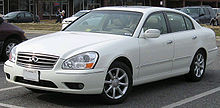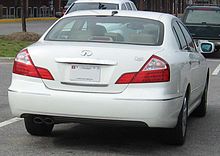Infiniti Q45
| Infiniti Q45 | |
|---|---|
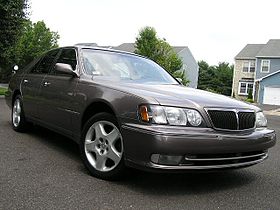 | |
| Overview | |
| Manufacturer | Infiniti (Nissan) |
| Also called | Nissan Cima |
| Production | August 1989 – 2006 |
| Assembly | Japan: Tochigi, Tochigi |
| Body and chassis | |
| Class | Full-size luxury car |
| Body style | 4-door sedan |
| Layout | FR layout |
| Related | Nissan President |
| Chronology | |
| Successor | Infiniti M |
The Infiniti Q45 is a full-size luxury car which was sold by Nissan's Infiniti brand from 1989 until 2006. It is a rear wheel drive, four-door sedan powered by a V8 engine. Early generations were based on the automaker's Japanese-market flagship sedan, the Nissan President, while models produced after 1996 were based on the slightly smaller Nissan Cima. Exports of the Q45 ceased after 2006, but the Cima continued to be sold in Japan until August 2010, when production of both the Cima and President ended.
First generation (G50; 1989–1996)[edit]
| First generation (G50) | |
|---|---|
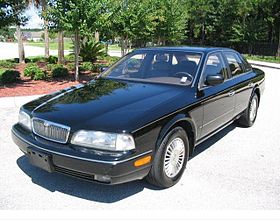 1994-1996 facelifted version | |
| Overview | |
| Also called | Nissan Infiniti Q45 (Japan and Australia)[1] |
| Production | August 1989 – June 1996 |
| Model years | 1990–1996 |
| Designer | Shunji Yamanaka (1987)[2][3] |
| Body and chassis | |
| Related | Nissan President |
| Powertrain | |
| Engine | 4.5L VH45DE V8, 280 PS (206 kW; 276 hp) |
| Transmission | 4–speed automatic |
| Dimensions | |
| Wheelbase | 1990–91: 2,875 mm (113.2 in) 1992–96: 2,880 mm (113.4 in) |
| Length | 5,090 mm (200.4 in) |
| Width | 1,825 mm (71.9 in) |
| Height | 1990–1993: 1,430 mm (56.3 in) 1994–1996: 1,425 mm (56.1 in) |
| Curb weight | 1,780–1,840 kg (3,924–4,057 lb) |
The first generation Q45 came to market in 1989 as a 1990 model. Car magazines and reviewers were impressed by the Q45's performance such as a 0–60 mph acceleration time of 6.7 seconds and handling. Its high-output 4.5 L V8 engine is rated at 278 hp (207 kW) and 292 lb⋅ft (396 N⋅m). All Q45s include a VLSD (viscous limited-slip differential), as part of a multi-link suspension. The name for the Q45 was inspired by the term "Q-car", implying a high-performance vehicle without a high-performance appearance. In Japan, it was sold as the Nissan Infiniti Q45, and was exclusive to Nissan Prince Store locations, as its platform twin the President was exclusive to Nissan Motor Store locations.
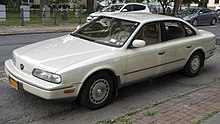
In terms of styling, the Q45 was a distinctive vehicle. Infiniti sought assistance from Italian furniture maker Poltrona Frau, and attempted to redefine the modern luxury sedan by offering a car with the usual amenities but with a decidedly modern bent.
All the usual things were present like a high-end Bose sound system, leather interior, power adjustable front passenger seats with two position memory feature that also electrically adjusted the steering wheel, exterior mirrors, one-touch power windows, digital climate control, and keyless entry system.
However, unlike competitors with cushy, couch-like seats, the Q45's leather seats were designed to be noticeably firmer. Further, also notably absent was woodgrain, as there was none to be found anywhere.
The car's interior was crafted to appeal to the sense of touch, using padded surfaces throughout the vehicle, with stark color contrasts such as a pearl white exterior with white leather upholstery, interior door panels, and carpeting with black floor mats, center console and dashboard.
It was equipped with an ergonomically designed and located window switch on the top of the door pull handle operated by the drivers thumb, and the instrument lighting being much more noticeable at night than during the day, using a reverse effect of white light on the gauges with black numbers. The Q45's use of a Cloisonné insignia instead of a conventional grille also caused buyers to shy away because of its unconventional, bottom breather appearance, and may have been influenced from the first generation Ford Taurus, the 1994 model year update featured a more conventional appearance including a more traditional appearing grille, woodgrain/chrome interior trim and cushy seats, drawing influences from the Nissan Maxima. More sedate performance figures, slower 17:1 steering (except on the Q45t, which retained the original 15.1:1 ratio), lower ratio 1st and 2nd gears, and a dynamically smooth suspension were all added in 1993 to make it a more status-quo luxury sedan. Other changes include thicker glass, keyless remote, auto-dim rear-view mirror, dipping side view mirrors, an improved transmission heat exchanger and external ATF filter, new oval intake ports and revised disc injectors, and fog lights. Metal-backed camshaft timing chain guides were added in 1993 to replace the earlier model's less reliable plastic guides.
The Q45 came in three variations: base, Q45t, and Q45a. The Q45t and Q45a featured a multi-link suspension at both the front and rear wheels, and included a rear stabilizer bar (with the " a " model being larger in diameter) and both models having a 1 mm smaller in diameter front sway bar, rear spoiler, BBS forged alloy wheels, 4-wheel steering. HICAS and the faster steering ratios was discontinued in the 1995 Q45t model and the Q45a model was not imported in 1996.
In 1989 (as a 1990 model) a full "active suspension (FAS)" was introduced. It employed 10 sensors sending signals to microprocessor-controlled hydraulic actuators at each wheel. It was designed to reduce body roll, dive and pitch and was very similar to Mercedes-Benz's Active Body Control, which was introduced in 1999 on the C215 CL-Class.
While Toyota's Lexus LS (and Honda's front-wheel drive flagship, the Acura Legend) were a stunning success, Infiniti Q45 sales never took off due in part to a notorious advertising campaign which did not include actual photos or information about the car.[4][5] Poor sales were also blamed on the car's unconventional styling, particularly the grille and lack of interior woodgrain or chrome trim.
In 1993 the Infiniti brand was launched in Australia with the sole model on offer being the Q45. With a price of A$140,000, the Q45 sold poorly and the brand was subsequently withdrawn from the market in 1996.[6][7] The G50 chassis continued in production in Japan until 2002 as the President in both regular and extended wheelbase versions. The Japanese version had many options that never appeared on the North American G50.
Second generation (FY33; 1997–2000)[edit]
| Second generation (FY33) | |
|---|---|
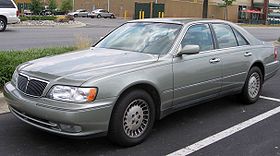 | |
| Overview | |
| Also called | Nissan Cima |
| Production | July 1996 – December 2000 |
| Model years | 1997 – 2001 |
| Designer | Itaru Sugino (1993) |
| Body and chassis | |
| Related | Nissan Cedric Y33 Nissan Gloria Y33 Nissan Leopard Y33 |
| Powertrain | |
| Engine | 4.1 L VH41DE V8 |
| Transmission | 4-speed automatic with manual shift |
| Dimensions | |
| Wheelbase | 2,830 mm (111.4 in) |
| Length | 1996-99: 5,056 mm (199.1 in) 2000-01: 5,069 mm (199.6 in) |
| Width | 1,820 mm (71.7 in) |
| Height | 2000-01: 1,445 mm (56.9 in) 1996-99: 1,450 mm (57.1 in) |
The Nissan President platform added a new model called the Nissan Cima in Japan, and Q45 in North America starting in 1996; this generation Q45 shared a platform with the older Nissan Cedric and Gloria which were of the shorter executive car class. The Japanese Cima replaced the Nissan Infiniti Q45 at Nissan Prince Store dealerships. This Q45 had a more conventional appearance but inferior performance with a smaller 4.1 L VH41DE engine that produced 266 hp (199 kW) and acceleration figures of 0-60 in about 7.5 seconds. From this model, both the Q45 and the Cima were merged. The all-multilink suspension was changed to struts at the front end, and was further tuned for comfort. The steering slowed down even more to an 18.5:1 ratio. Traction control was standard. None of this did much to help the car's sales; Q45 sales in the North American market remained much lower than sales of its primary competitor, the Lexus LS.[citation needed]
The 2000 Q45 Anniversary Edition had the highest trim level available for the second-generation Q45. This trim level was standard on the 2001 models. The Q45t was the most expensive vehicle in the Infiniti (excluding the AE for 2000) lineup and offered enhanced performance, a rear spoiler, heated seats, dynamically adjusted shock absorbers and other luxurious features not available in a standard Q45.
The car's appearance was slightly altered for 1999. For this year, HID headlights were added and the analog clock returned. Minor styling changes were made to the front and rear fascias. 17" wheels and an electronic adjustable suspension became standard on the Q45t. Numerous safety improvements in 1998 model were augmented in the 1999 and 2000 models.
Standard features for the second-generation Q45 included a leather interior with fake woodgrain trim, but no dual climate control, a Bose audio system with eight speakers with an in-dash single disc CD player, auto dimming rear view mirror, automatic light on and delay off timer, and steering wheel-mounted cruise control and head unit control. Also standard was a memorized adjustment system for the driver's seat and steering wheel. A CD changer and heated seats were available as options.
The car was sometimes derisively referred to as the "Q41" due to its reduced displacement and lesser performance. Nearly all Infinitis before or since have used a two-digit number following a letter to indicate displacement; the second-generation Q was an exception (as was the Nissan Pathfinder clone QX4).
Third generation (F50; 2001–2006)[edit]
| Third generation (F50) | |
|---|---|
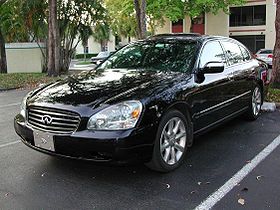 | |
| Overview | |
| Also called | Nissan Cima |
| Production | January 2001 – 2006 |
| Model years | 2002–2006 |
| Designer | Mamoru Aoki (1998) Yasuhiro Tani (facelift: 2003)[8] |
| Body and chassis | |
| Related | Nissan President |
| Powertrain | |
| Engine | 4.5 L VK45DE V8 |
| Transmission | 5-speed automatic |
| Dimensions | |
| Wheelbase | 2,870 mm (113.0 in) |
| Length | 2001-04: 5,069 mm (199.6 in) 2004-06: 5,101 mm (200.8 in) |
| Width | 1,844 mm (72.6 in) |
| Height | 2001-04: 1,495 mm (58.9 in) 2004-06: 1,490 mm (58.7 in) |
Introduced as a concept at the 2000 New York Auto Show, the Q45 was completely redesigned for 2002, as was the JDM Cima and the President. This Q45 focused on performance again with a new 340 hp (253 kW) 4.5 L VK45DE V8 engine, Gatling gun inspired HID headlights, and sharper styling. The car featured a 5-speed automatic transmission with overdrive. Development began in 1996, with exterior designs under Mamori Aoki being frozen in 1998 and patented in March 2000.[9][10]
It was the first Infiniti with laser Autonomous cruise control system.
Despite good reviews, sales remained poor — just 1129 were sold in the United States for all of 2005. This Q45 has received praise from Car and Driver, Edmunds and Consumer Guide.[11][12][13][14] Low sales are attributed not to the car’s overall quality or performance, but to lack of advertising and the debatable prestige of the Infiniti brand.
The 2003 model was given a number of under the skin upgrades including a new security system, a numerically higher final drive ratio (for better acceleration - decreasing highway fuel economy), reprogrammed TCU, and during the year, a satellite radio option. The CD player was now a one at a time feed into the dash. The Q45 received a number of upgrades for the 2005 model year, including new front and rear fascias, restyled hood and grille, restyled trunk lid, new headlight design, integrated fog lights and LED taillights. Inside were new contoured double-stitched seats, white luminescent gauge markings, chrome accents and dark maple trim. 2005 upgrades also included a recalibrated transmission and new 17" alloy wheels.
The following features were standard in the Q45: all-leather interior, power sunroof, 8-way power front seats, remote keyless entry, rain-detecting wipers and side curtain airbags. Standard electronics include: CD, 8 Bose speakers, trip computer, RearView Monitor parking camera system, and a voice-activated navigation system. The 2002 Q45 was the first vehicle to ever offer voice-activated navigation controls and a reverse parking camera outside Japan, following the JDM 1991 Toyota Soarer. The car seated five and had a base price of US$56,200.
Replacement[edit]
The Q45 was no longer exported to the USA after 2006, being unintentionally replaced by a newly redesigned M35 and M45. While the M45 has a shorter length than the Q45, it boasts more interior room, greater performance, a superior rear multilink suspension and front double wishbone, and much friendlier ergonomics, so it succeeded the Q45 as Infiniti's flagship.
A new Q flagship was anticipated by the end of the 2000s decade. According to Mark Igo, the general manager of Infiniti North America, "the new Q will make the brand better, but it is questionable whether it will be very profitable".[15]
Infiniti introduced the next iteration of its flagship, the Y51 series Infiniti M37/56/Nissan Fuga in November 2009. The new Infiniti M is only 50 mm (2.0 in) shorter than the final generation Q45, with the same width dimensions of 1,845 mm (6.1 ft) and height of 1,515 mm (5.0 ft) compared to the F50 series Cima of 1,490 mm (4.9 ft) height.
By August 2010 the Nissan Cima, on which the final generation Q45 essentially was, had been discontinued in Japan, along with its Nissan President sibling. This made the second generation Nissan Fuga the marque's top-of-the-line flagship sedan. When the Fuga assumed the role as flagship sedan of Nissan Japan August 2010, it became the first time that Nissan didn't sell a premium luxury V8 sedan in Japan, although the Fuga's North American cousin, the Infiniti M56, is offered with a V8 shared with the Infiniti QX56.
In May 2012, Nissan released a new version of the Cima in Japan, based on the Fuga Hybrid (Infiniti M35h).[16]
On 17 December, 2012, Infiniti announced that all of its future sedan offerings will use the Q prefix, starting from the Q50 as a G37 replacement, Q70 for its M35/45/56 replacement, and a rumored Q80 for the new flagship model.[17]
References[edit]
- ^ Tony Davis, The New Car Buyers Guide No 6, Australia's Premier Passenger Car Guide, 1994, page 174
- ^ Hsu, Ben. "25 YEAR CLUB: The Infiniti Q45 is officially a Japanese Nostalgic Car".
- ^ "山中俊治 - 日本デザインコミッティー".
- ^ "Infiniti water commercial". Youtube. Retrieved 2 February 2017.
- ^ "Infiniti Launch Commercial". Youtube. Retrieved 2 February 2017.
- ^ "Next Car's prediction of Infiniti's local release confirmed". Next Car. 22 March 2011. Retrieved 14 March 2012.
- ^ Fallah, Alborz (18 May 2006). "Nissan to bring the Infiniti Brand to Australia?". CarAdvice. Retrieved 14 March 2012.
- ^ "Home". Retrieved 15 July 2015.
- ^ "Nissan Shows Early Fruits Of Renault Union". tribunedigital-chicagotribune. Retrieved 15 July 2015.
- ^ Michael Frank (5 February 2001). "Infiniti's Q Factor". Forbes. Retrieved 15 July 2015.
- ^ "Cadillac DTS vs. Jaguar S-type 4.0, M-B E430, Infiniti Q45, Lexus GS430, Audi A6 4.2 Quattro, BMW 540i - Comparison Tests". Caranddriver.com. Retrieved 2011-07-31.
- ^ "Sports Sedans Supreme: 2007 Maserati Quattroporte Executive GT vs 2007 Audi S8 vs 2007 Mercedes-Benz S63 - Latest News, Features, and Road Tests - Automobile Magazine". Automobilemag.com. 2010-12-13. Retrieved 2011-07-31.
- ^ "BMW 760Li, Mercedes-Benz S63 AMG, Porsche Panamera Turbo - Luxury Sport Sedan Comparison - Automobile Magazine". Automobilemag.com. 2010-12-13. Retrieved 2011-07-31.
- ^ "Entry-Level Fullsize Luxury Sedan Comparison". Motor Trend. 2010-12-13. Retrieved 2011-07-31.
- ^ "New Infiniti Q flagship still in doubt - MotorAuthority - Car news, reviews, spy shots". MotorAuthority. Retrieved 2009-06-25.
- ^ "Nissan Releases All-New Cima". Archived from the original on 2016-03-03. Retrieved 2012-12-29.
- ^ "Infiniti Unexpectedly Changing All Model Names to Q, QX for 2014, Confirms New Range-Topping Sedan". Car And Driver. Retrieved 2013-03-21.
External links[edit]
| Wikimedia Commons has media related to Infiniti Q45. |
- Official Infiniti USA site
- Q No Longer Available, See Infiniti M
- Official Canadian site
- 1997 Q45 vs 1997 Lexus LS 400 Motor Trend article
| show Infiniti, a division of Nissan Motor Co., Ltd., road car timeline, 1990–present
|
|---|
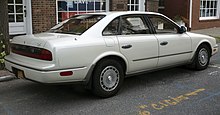
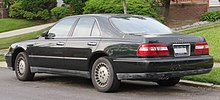
.jpg)
